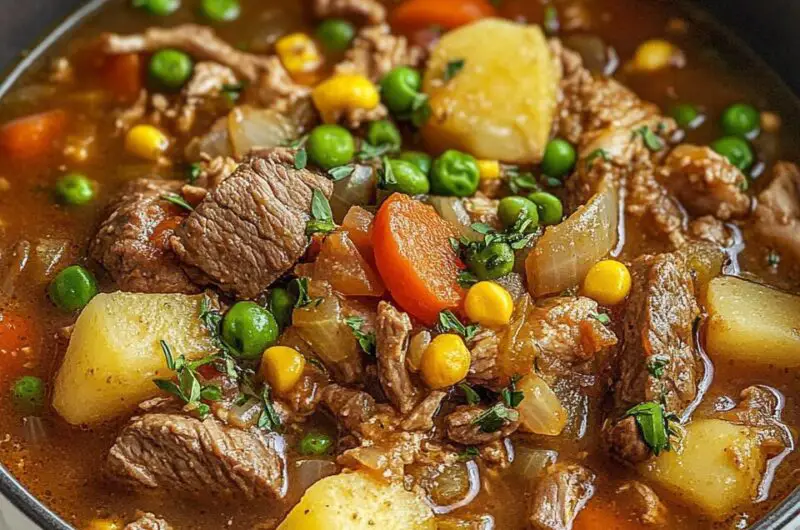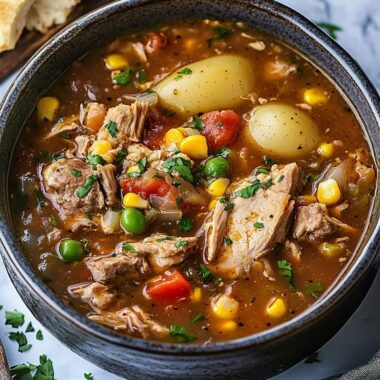The Midwest Booyah Stew is a legendary comfort dish that brings together tender beef, juicy chicken, and a medley of hearty vegetables in one soul-warming pot. This stew is traditionally prepared in large batches during community gatherings, making it a symbol of warmth, family, and togetherness. With layers of slow-simmered flavor, Booyah is more than just a meal it’s an experience. The combination of simple, wholesome ingredients and the rustic cooking process creates a rich broth and satisfying bite every time. Whether you’re feeding a crowd or meal-prepping for the week, this timeless stew is your go-to for nourishment and nostalgia.
Full Recipe:
Ingredients:
-
2 tablespoons vegetable oil
-
2 pounds beef stew meat, cut into cubes
-
1 whole chicken (3-4 pounds), cut into parts
-
1 large onion, chopped
-
3 cloves garlic, minced
-
2 celery stalks, diced
-
3 carrots, peeled and sliced
-
3 potatoes, peeled and cubed
-
1 green bell pepper, chopped
-
1 cup green beans, trimmed and halved
-
1 cup corn kernels (fresh or frozen)
-
1 can (14 oz) diced tomatoes
-
8 cups beef or chicken stock
-
2 bay leaves
-
1 teaspoon dried thyme
-
1 teaspoon paprika
-
Salt and black pepper to taste
-
1/4 cup fresh parsley, chopped
Directions:
-
Heat oil in a large stockpot over medium heat. Brown the beef cubes on all sides, then remove and set aside.
-
Add the chicken pieces to the pot and sear until lightly browned. Remove and set aside.
-
In the same pot, add the chopped onion and garlic. Sauté for 3-4 minutes until softened.
-
Return the beef and chicken to the pot. Pour in the stock and add bay leaves, thyme, paprika, salt, and pepper. Bring to a boil, then reduce heat and simmer uncovered for 1 hour.
-
Add carrots, celery, potatoes, bell pepper, green beans, corn, and diced tomatoes. Continue to simmer for 45 minutes to an hour, or until all the vegetables are tender and the meat is fully cooked.
-
Remove bay leaves and chicken bones (if used whole chicken).
-
Stir in chopped parsley before serving. Serve hot with crusty bread.
Prep Time: 25 minutes | Cooking Time: 1 hour 45 minutes | Total Time: 2 hours 10 minutes
Kcal: 375 kcal | Servings: 8 servings
Booyah Stew: A Midwestern Culinary Tradition Worth Celebrating
When the chill of autumn settles over the Midwest, and the trees explode in color, there’s no dish more heartwarming or more rooted in tradition than Booyah Stew. A slow-simmered, meat-and-vegetable-heavy concoction with origins in Upper Midwest communities, Booyah is more than just a stew. It’s a local legend, a cultural event, and a nostalgic reminder of community, family, and shared tables.
In this article, we’ll explore the story behind Booyah, its significance in Midwestern communities, regional variations, serving tips, and why this dish still holds a special place in many hearts today.
The Origins of Booyah
Booyah Stew traces its roots to Belgian immigrants who settled in parts of Wisconsin, Minnesota, and Michigan in the late 19th and early 20th centuries. The dish is believed to be derived from the French word “bouillon,” meaning broth or boiled liquid. Over time, the pronunciation and spelling evolved into the now-iconic “Booyah.”
Some food historians speculate that the name may also stem from a phonetic spelling by a Belgian-American who wrote down his family’s “bouillon” recipe as “booyah,” further popularizing the quirky name. While the etymology may be up for debate, there’s no mistaking the sense of comfort and heritage this stew brings to Midwestern tables.
A Dish Designed for Community
What sets Booyah apart from other stews isn’t just its ingredients but its scale. Traditionally, Booyah was cooked in enormous cauldrons over open flames, sometimes taking 2–3 days to prepare and feed hundreds of people. It wasn’t just food it was a social event.
Church picnics, county fairs, community fundraisers, and family reunions all became opportunities to gather and share a pot of Booyah. In fact, in many towns across Wisconsin and Minnesota, Booyah cook-offs are still a fall staple.
Booyah isn’t a dish made in isolation. It’s a meal that’s meant to be stirred, served, and savored among friends and neighbors. It represents Midwestern values: generosity, patience, hospitality, and a deep connection to land and community.
What Makes Booyah Unique?
At first glance, Booyah might resemble other stews think of beef stew, chicken soup, or even vegetable chowder. But the difference is in the layers of meat, the diversity of vegetables, and the depth of flavor from slow cooking.
A traditional Booyah features a combination of meats, usually beef and chicken, sometimes even pork. The base is a rich, slow-cooked stock enhanced by aromatic vegetables like onions, garlic, celery, carrots, and potatoes. Bell peppers, corn, green beans, and tomatoes are often added for color and sweetness.
The broth is never hurried it’s simmered for hours to extract every bit of flavor. Seasonings like bay leaf, thyme, paprika, and parsley lend complexity, while the variety of vegetables changes depending on what’s in season or available locally.
Unlike more minimalist stews, Booyah is hearty, filling, and almost celebratory in its abundance. It’s a one-pot wonder that symbolizes home and heritage.
Regional Variations
As with many traditional dishes, Booyah adapts to its location and the cook preparing it. Here are a few notable regional twists you might encounter:
-
Wisconsin Booyah – Often considered the “heartland” of Booyah culture, Wisconsin’s version frequently features barley or rice as a filler, especially in rural areas. Large cookouts often use Booyah kettles big enough to hold 50 gallons or more of stew.
-
Minnesota Booyah – With strong Scandinavian and German influences in the state, you may find recipes that include cabbage or root vegetables like rutabaga and parsnip, adding earthiness to the dish.
-
Michigan’s Upper Peninsula – Known for its rugged winters and hearty food, UP Booyah often goes heavy on meat and includes dumplings or egg noodles as a final touch.
Though the core principles of Booyah remain the same multiple meats, root vegetables, long simmer times each cook and town adds a personal spin that reflects their cultural background and available resources.
Booyah as a Seasonal Staple
While Booyah can technically be made any time of year, it’s especially beloved during the fall and winter months, when people crave warming, filling meals that are best shared in big batches.
It’s the kind of dish that begs to be made in large quantities so you can refrigerate or freeze portions for easy weeknight meals. Its robust flavors even improve after a day in the fridge, making it ideal for meal prepping.
For outdoor gatherings, tailgates, or fall festivals, Booyah is often paired with crusty bread, pickles, and buttered rolls. It’s a complete meal in a bowl no sides necessary, though a slice of pumpkin pie certainly wouldn’t hurt.
Tips for the Perfect Booyah
If you’re preparing Booyah at home and not for a crowd of 100, you can scale down the recipe but still capture the essence of the dish. Here are some expert tips to get it right:
-
Use a heavy-bottomed pot – A Dutch oven or large stockpot works best to maintain even heat and reduce the risk of scorching.
-
Brown the meat first – Searing your beef and chicken before adding the liquids adds depth and richness to the final flavor.
-
Layer your vegetables – Add hearty vegetables like potatoes and carrots earlier in the cook, but save quick-cooking ones like green beans and corn for later to preserve texture.
-
Simmer, don’t boil – Slow and low is the key to melding all the flavors together and achieving that comforting, slightly thickened consistency.
-
Make it ahead – Booyah tastes even better the next day as the flavors continue to develop.
Modern Twists and Dietary Swaps
For a modern audience, Booyah can be adjusted to meet different dietary preferences without sacrificing its heartiness.
-
Vegetarian Booyah – Substitute legumes like chickpeas or white beans in place of meat, and opt for vegetable broth. Add mushrooms for an umami punch.
-
Low-sodium or gluten-free – Use homemade broth or certified low-sodium stock, and avoid any thickeners that contain gluten.
-
Spiced-up version – Add chili flakes or a dash of hot sauce to kick the stew up a notch, which can complement the sweetness of the vegetables.
Booyah’s flexibility makes it not only comforting but inclusive, which is yet another reason for its lasting popularity.
Advertisement
Why Booyah Still Matters
In today’s fast-paced world, the tradition of Booyah reminds us to slow down, gather around the table, and share a meal that takes time, love, and care to prepare. In a single pot, Booyah holds generations of flavor, culture, and memory. It invites conversation, fuels togetherness, and honors culinary heritage.
Whether you’re cooking it from scratch at home or enjoying it at a community event in a small Midwestern town, Booyah offers a taste of something more than just food it offers a taste of tradition.
Conclusion:
Booyah Stew is a celebration of everything that makes Midwestern cuisine special humble ingredients, robust flavor, and a deep connection to people and place. From its immigrant roots to its role in modern communal gatherings, Booyah tells a story in every bite.
If you haven’t tried it yet, you’re in for a treat. Cook up a batch this weekend, invite some friends over, and discover why this timeless stew remains one of the Midwest’s most cherished dishes.








